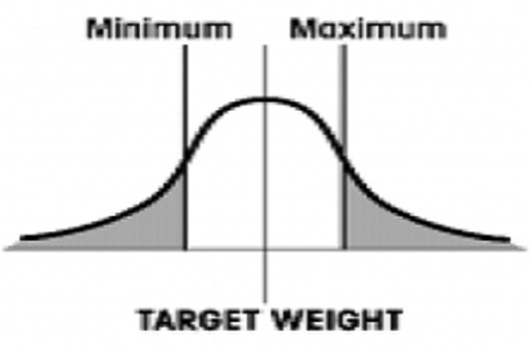Definition of zone limits in check weigher?

DEFINITION OF ZONE LIMITS IN CHECKWEIGHER
Zone limits are weight values entered by an operator or packaging personnel to create breakpoints between consecutive weight zones. These limits are used as a filter to allow acceptable weight packages along the production line. The accurate adjustment of zone limits depends on the object you are dealing with and the control process.
If your CheckWeigher accuracy is ±1g, for instance, in the zone limits of a 1g range, a product can be accepted or rejected. Therefore, zone limits should be selected at a point where there is zero chance of a product that is either too light or too heavy being accepted by the CheckWeigher. A weight zone is the range between zone limits. Most CheckWeighers have 3 or 5 zones. Some CheckWeighers have 2 or 4 zone limits, which is essentially the same. In a 3-zone CheckWeigher, there are 2 zone limits. The center zone is between the upper and lower zone limits, indicating the range of acceptable weight values. In a 5-zone CheckWeigher, there are 4 zone limits. The center zone is usually the acceptance zone, and the zones on either side are warning zones used to alert the operator when deviations from acceptable weight values occur. The two outer zones in 3 or 5-zone CheckWeighers are regions where weights are not accepted. Figure 0-12 illustrates a 3-zone CheckWeigher.
HOW TO DETERMINE OPTIMAL ZONE LIMIT SETTINGS?
Zone limits are based on the acceptable weight variation of weighed products and are set below the accuracy of the CheckWeigher. The question of setting zone limits has as many answers as applications in controlled weighing. It depends on what you are looking for and what you are trying to achieve. Smaller zone limits in any given CheckWeigher will result in more acceptable products being misclassified.
1. Begin by setting your target weight value to determine zone limits.
Decide on your rejection percentage target based on your production cost and calculate the target weight value considering the change in the filling machine and the rejection percentage.
2. Then, limit the acceptable weight zones within 2 or 3 standard deviations of the CheckWeigher accuracy from the maximum and minimum weight changes.
Expand MIN. AND MAX. Values According to CheckWeigher Accuracy
If you set your zone limits within 2 standard deviations of the CheckWeigher accuracy from the maximum and minimum allowable weights, you will understand that at least 95% of the accepted products are correctly classified. With a more traditional adjustment using 3 standard deviations of CheckWeigher accuracy, you can understand that 99.7% of the products are correctly classified. If you are filling a product and need to adjust the net content, you should choose a target weight value slightly higher than the value on your package label. The CheckWeigher will help you balance how much the product is rejected due to being underweight, allowing you to lower the target weight value. Your CheckWeigher can only be as good as the preceding process. If there is little control over the weight change in your container, the CheckWeigher following the filling will provide the gross weight, not the net weight. Gross and net systems are weighed with empty and full containers and can be used to calculate the weight change of the container. The same is true for any application. The more significant the weight change within the product, the more challenging it is to check the weight of a single product without considering the accuracy of the CheckWeigher.
Searching for and Counting Lost Parts
1- If you want to find the number of packages or a lost product, consider the average weight distribution of the lightest product. Compare the total of the average weight distribution with the average of the normal weight distribution plus and minus the smallest product. If there is an extra particle, you may not be concerned as much as a missing particle. Determine your zone limits when you think the count is correct. Smaller zone limits are shown in Figure 0-17 to demonstrate the comparison of a target package's weight distribution curve with a situation where a particle is missing.
2- Narrow down your zones based on the accuracy of your CheckWeigher.
A CheckWeigher more efficiently captures lost products when lower uncontrollable weight changes in the product are compared with the weight of each product. In the graph 0-17, the distribution is so large that the CheckWeigher will reject correct products without looking at its own accuracy, as if a particle were missing. In this case, a gross-net system with a high container weight change can help. Otherwise, you may want to look for a solution other than controlled weighing.
